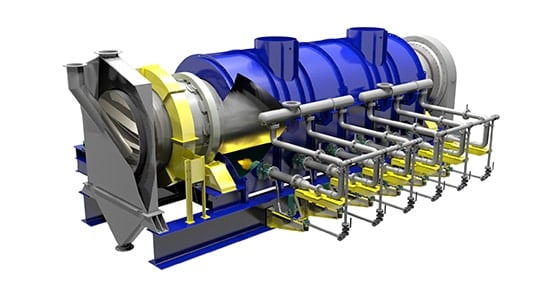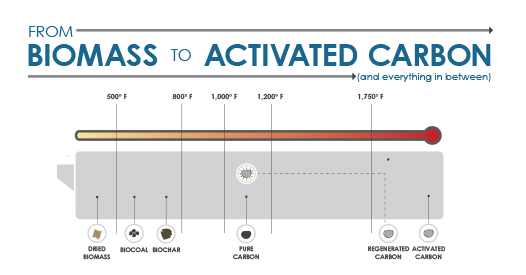The biomass industry has seen steady growth the past few years, as nations around the globe continue to shift focus toward more renewable energy sources.
And while biomass offers direct uses in itself, it can also be converted to a number of carbon products, all of which are created through thermal processing in an indirect rotary kiln, also often referred to as a pyrolysis kiln.
Biomass offers significant potential to improve the world around us through a range of products and applications.
Click the image below to view the infographic.
Biomass
Biomass begins its journey as organic matter, the source of which can vary significantly: animal remains and by-products, plants, forest product residuals, and even residuals leftover from the agricultural industry can all serve as a source of biomass.
Biomass alone can be utilized as a source of energy, either through burning it directly as a source of heat, or by converting it into a biofuel for use as an alternative energy source. Similarly, it can be converted into biomass pellets for use as an energy source.
In addition to these uses, biomass can be upgraded into several higher value products.
Biocoal
One common higher value carbon product produced from biomass is biocoal. Biocoal is a form of synthetic or man made coal that can take the place of, or be co-fired with fossil-fuel based coal products in energy plants.
To produce biocoal, biomass is torrefied in an inert (oxygen-free) environment. This is typically carried out using an indirect rotary kiln (also referred to as a calciner).
Dried wood biomass is processed at around 500 – 800º F for a specific amount of time in order to upgrade it to biocoal. This pyrolysis process further reduces the moisture content, upgrades the energy value, and causes the material to become hydrophobic, meaning it will not absorb moisture from the air like lower-grade biomass products might.
Biochar
Biochar is also a product upgraded from biomass. Biochar is similar to biocoal, but is made with a completely different intention; biochar is utilized as a soil amendment.
The production of biochar is the same as biocoal, with dried biomass being processed in a kiln at around 500 – 800º F for a set amount of time.
Interest in biochar has surged over the past few years, due to it’s restorative capabilities in soil, as well as the potential for it to sequester carbon in soil, reducing greenhouse gases. Furthermore, biochar can also be used in soil remediation applications.
Pure Carbon
At temperatures between 1,000 – 1,200º F, the biochar or biocoal product transitions to a pure carbon material through carbonization. At these temperatures, 75 – 90% of the volatile components existing in the material are removed.
Pure carbon has few applications for which it can be used, though it can be used as a filler in plastics.
Activated Carbon
At temperatures between 1750 – 1850º F, injecting air, carbon dioxide, or steam into the pure carbon causes activation. This removes any remaining volatile components and through endothermic reaction, converts the carbon to what is known as activated carbon – the highest value product that can be created from biomass.
Activated carbon is a versatile material used throughout a number of industries as a powerful adsorbent. It aids in air pollution control, contaminated water treatment, and more.
Various grades and forms of activated carbon can be produced, each suited to different applications.
Transforming Biomass to Activated Carbon
While the process and parameters for converting biomass to activated carbon can differ depending on the source and characteristics of the feedstock material, the desired end product characteristics, and more, in general, the process follows the stages outlined below.
Drying
Before biomass can be used in any application or upgraded, it must first be dried.
Drying is commonly carried out in a rotary dryer. After drying, biomass can move on to conversion to a higher value product, or be used as a fuel source.
Devolatilization/Carbonization
Devolatilization, or carbonization, is the process of removing volatile components from the material, thereby creating a higher-value carbon product.
After drying, at around 1,000 to 1,200º F, devolatilization occurs. As mentioned, this step removes the majority of volatiles contained within the material.
Activation
Once the material has been devolatilized, activation can take place. This is most commonly done by injecting steam into the process, which “activates” the material by clearing out the porous structure, leaving a material ready to be used as an adsorbent.
Indirect Kilns for Processing Biomass into Activated Carbon
An indirect rotary kiln, sometimes referred to as a calciner or pyrolysis kiln, is a thermal processing device that utilizes controlled, high temperatures and retention time to cause a physical change or chemical reaction within a material. The rotating drum is externally heated to maintain an inert processing environment within the kiln.
Conclusion
Biomass is a diverse material, offering a wealth of opportunity for more renewable energy resources, as well as high-value carbon products with a multi-faceted range of applications. Rotary kilns are an integral component to producing high value products from biomass feedstock.
FEECO provides custom rotary kilns for the production and regeneration of activated carbon, as well as the production of biochar and biocoal. In addition, we also offer rotary dryers and complete dryer islands for biomass drying. For more information, contact us today!




